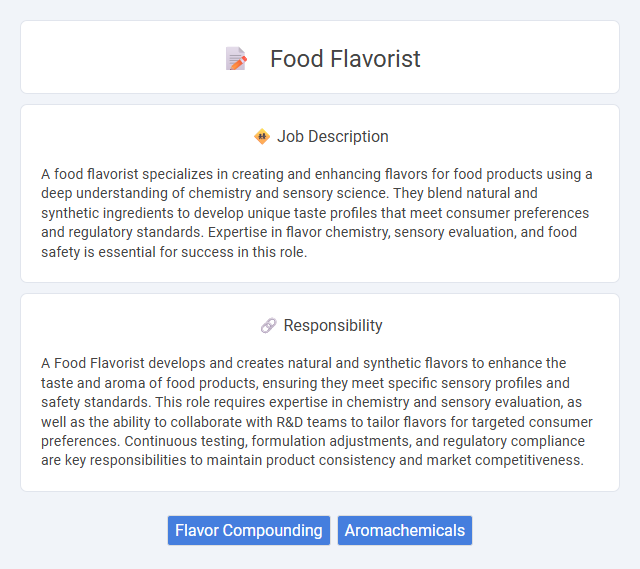
A food flavorist specializes in creating and enhancing flavors for food products using a deep understanding of chemistry and sensory science. They blend natural and synthetic ingredients to develop unique taste profiles that meet consumer preferences and regulatory standards. Expertise in flavor chemistry, sensory evaluation, and food safety is essential for success in this role.
People with a strong sense of taste and smell, along with creativity and attention to detail, are likely to be well-suited for a Food Flavorist role. Those who enjoy working in laboratory settings and have an interest in food science may find this career fulfilling. Individuals with allergies to food ingredients or sensitivities to chemicals might face challenges in this profession.
Qualification
A Food Flavorist requires a strong background in chemistry, particularly organic chemistry, with a bachelor's degree or higher in food science, chemistry, or biochemistry often preferred. Expertise in sensory science, flavor chemistry, and formulation techniques is essential to create and modify flavors that meet product specifications and regulatory standards. Proficiency with analytical instruments such as gas chromatography-mass spectrometry (GC-MS) and skills in product development are critical qualifications for ensuring high-quality and innovative flavor solutions.
Responsibility
A Food Flavorist develops and creates natural and synthetic flavors to enhance the taste and aroma of food products, ensuring they meet specific sensory profiles and safety standards. This role requires expertise in chemistry and sensory evaluation, as well as the ability to collaborate with R&D teams to tailor flavors for targeted consumer preferences. Continuous testing, formulation adjustments, and regulatory compliance are key responsibilities to maintain product consistency and market competitiveness.
Benefit
A Food Flavorist likely enjoys a career offering creative opportunities to develop unique taste profiles that enhance consumer satisfaction. This role may provide the benefit of working at the intersection of science and culinary art, fostering innovation in food products. Job prospects might include collaboration with food manufacturers, potentially leading to impactful contributions in the food industry and personal career growth.
Challenge
The role of a food flavorist likely involves complex challenges in balancing natural and artificial ingredients to achieve desired taste profiles. Meeting strict regulatory standards while ensuring product safety and consumer satisfaction may present ongoing difficulties. Adapting to rapidly changing consumer preferences and incorporating new scientific advancements could further complicate flavor development processes.
Career Advancement
Food flavorists advance their careers by gaining expertise in chemistry, sensory analysis, and flavor formulation, often progressing from junior roles to senior flavor creation positions. Mastery in emerging technologies such as natural flavor extraction and AI-driven flavor design enhances their value in the food industry. Leadership opportunities include becoming flavor development managers or heading research teams in multinational food corporations.
Key Terms
Flavor Compounding
A Food Flavorist specializing in flavor compounding expertly blends natural and synthetic ingredients to create distinctive, appealing tastes for various food products. This role requires deep knowledge of chemical properties, sensory evaluation, and regulatory compliance to ensure safe and consistent flavor profiles. Precision in balancing aroma, taste, and texture elements drives innovation and enhances consumer experience across diverse food categories.
Aromachemicals
A Food Flavorist expertly blends aromachemicals to create appealing and authentic flavors in food products. Mastery of natural and synthetic aromachemicals is essential to replicate or enhance taste profiles while meeting safety regulations. Their innovative use of aromachemicals drives the development of unique flavors that cater to evolving consumer preferences and industry standards.
 kuljobs.com
kuljobs.com